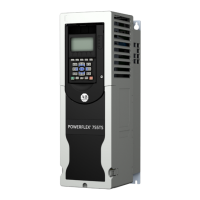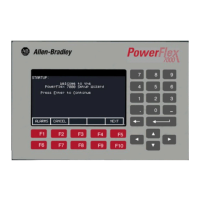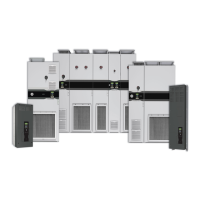2-32 Autotune
Next, the Dynamic or Static Autotune should be performed:
• Dynamic - the motor shaft will rotate during this test. The dynamic
autotune procedure determines both the stator resistance and motor flux
current. The test to identify the motor flux current requires the load to be
uncoupled from the motor to find an accurate value. If this is not possible
then the static test can be performed.
• Static - the motor shaft will not rotate during this test. The static test
determines only [IR Voltage Drop]. This test does not require the load to
be uncoupled from the motor.
The static and dynamic tests can be performed during the Start-up routine
on the LCD HIM. The tests can also be run manually by setting the value of
the [Autotune] parameter to 1 “Static Tune” or 2 “Rotate Tune”.
Alternate Methods to Determine [IR Voltage Drop] & [Flux Current Ref]
If it is not possible or desirable to run the Autotune tests, there are three
other methods for the drive to determine the [IR Voltage Drop] and [Flux
Current] parameters:
• The first method is used when the motor nameplate parameters are left at
default. When the drive is initially powered up, the [Autotune]
parameter is defaulted to a value of 3 “Calculate”. The values for [IR
Voltage Drop] and [Flux Current] are calculated based on the default
motor nameplate data. This is the least preferred method.
• The second method calculates them from the user-entered motor
nameplate data parameters. When [Autotune] is set to 3 “Calculate”, any
changes made by the user to motor nameplate HP, Voltage, or Frequency
activates a new calculation. This calculation is based on a typical motor
with those nameplate values.
• Finally, if the stator resistance and flux current of the motor are known,
the user can calculate the voltage drop across the stator resistance. Then
set [Autotune] to 0 “Ready” and directly enter these values into the [Flux
Current] and [IR Voltage Drop] parameters.
Autotune Procedure for Flux Vector
For FVC vector control an accurate model of the motor must
be used. For this reason, the motor data must be entered and the autotune
tests should be performed with the connected motor.
Motor nameplate data must be entered into the following parameters for the
Autotune procedure to obtain accurate results:
• [Motor NP Volts]
• [Motor NP FLA]
• [Motor NP Hertz]
• [Motor NP RPM]
• [Motor NP Power]
• [Motor Poles]
Vector
FV
